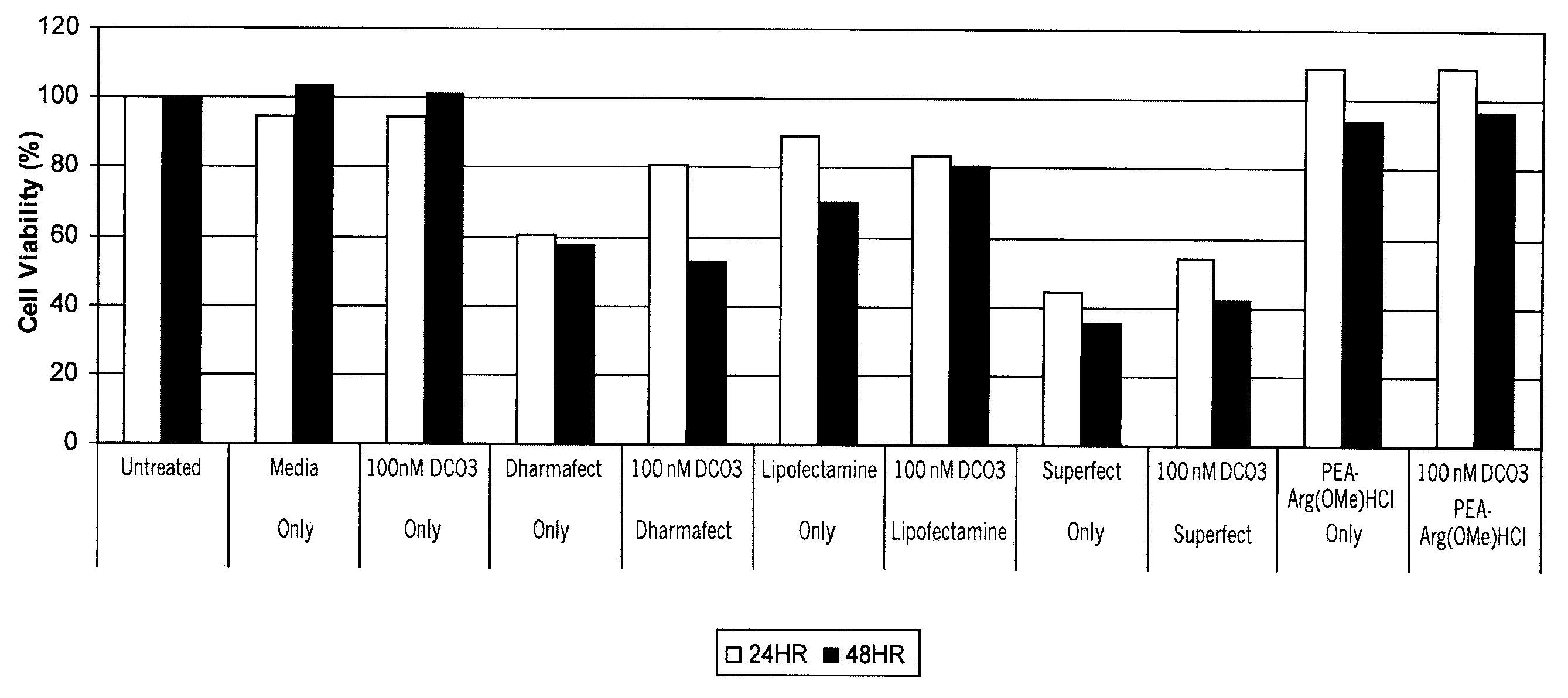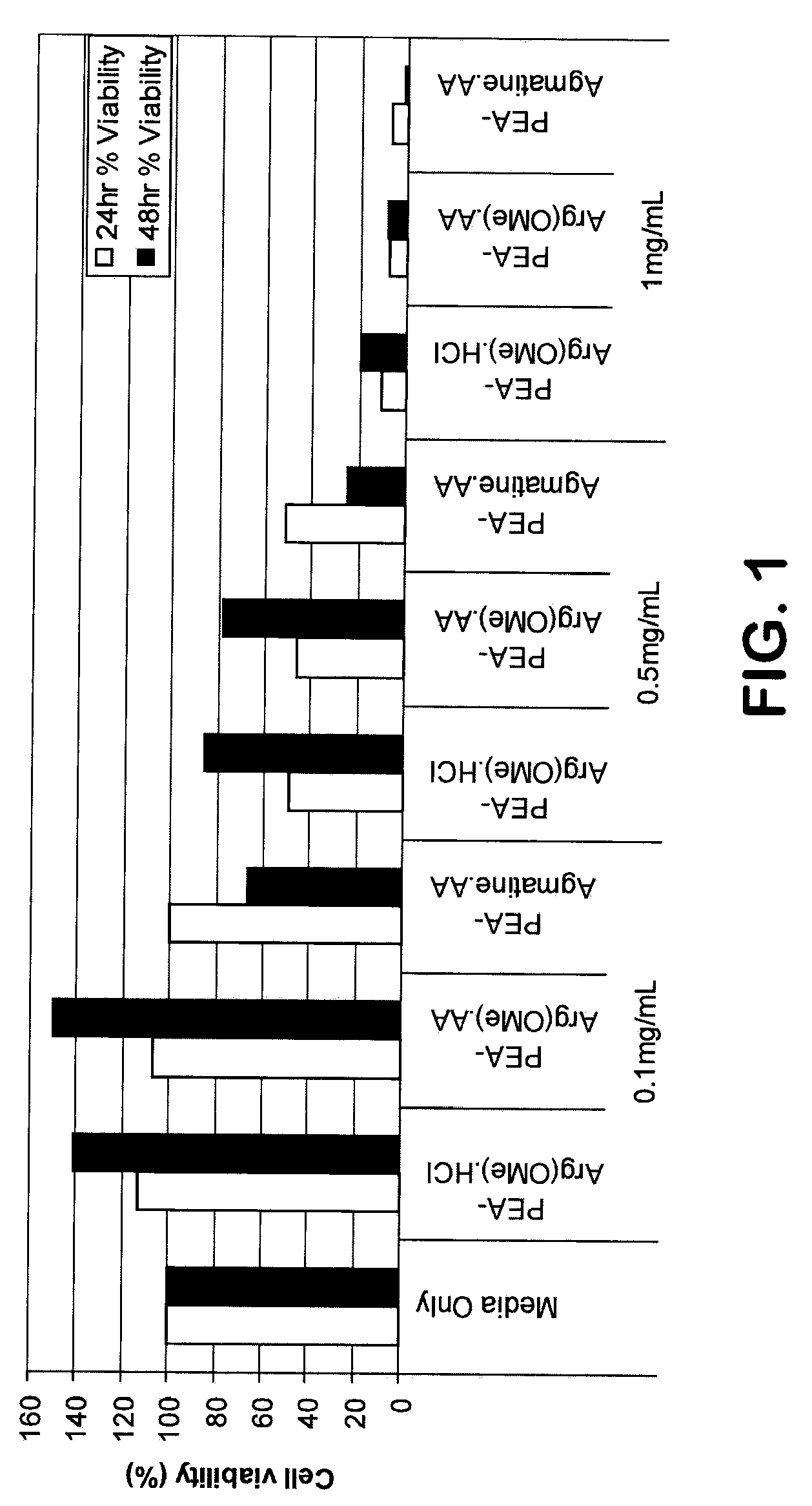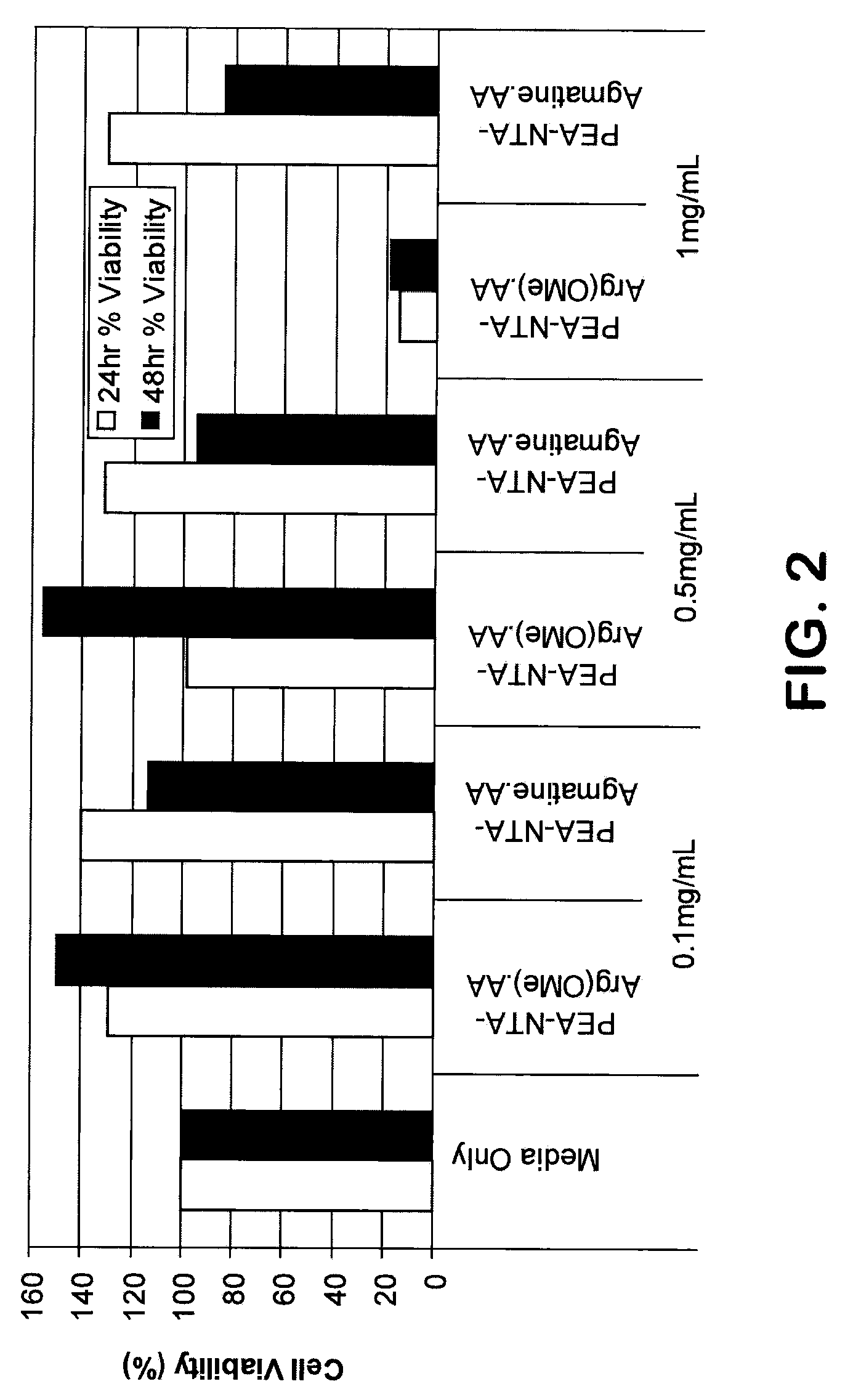Cationic alpha-amino acid-containing biodegradable polymer gene transfer compositions
a technology of biodegradable polymer and composition, applied in the field of cationic alphaamino acidcontaining biodegradable polymer gene transfer composition, can solve the problems of small success rate, lack of safe, efficient and controllable gene transfer methods, and the use of viral vectors for human clinical use has historically encountered limitations
- Summary
- Abstract
- Description
- Claims
- Application Information
AI Technical Summary
Problems solved by technology
Method used
Image
Examples
example 1
A. Materials Characterization
[0103]The chemical structure of monomers and polymers were characterized by standard chemical methods; NMR spectra were recorded by a Bruker AMX-500 spectrometer (Numega R. Labs Inc. San Diego, Calif.) operating at 500 MHz for 1H NMR spectroscopy. Deuterated solvents CDCl3 or DMSO-d6 (Cambridge Isotope Laboratories, Inc., Andover, Mass.) were used with tetramethylsilane (TMS) as internal standard.
[0104]Melting points of synthesized monomers were determined on an automatic Mettler-Toledo FP62 Melting Point Apparatus (Columbus, Ohio). The number and weight average molecular weights (Mw and Mn) and molecular weight distribution of synthesized polymers were determined by Model 515 gel permeation chromatography (Waters Associates Inc. Milford, Mass.) equipped with a high pressure liquid chromatographic pump, a Waters 2414 refractory index detector. 0.1% of LiCl solution in N,N-dimethylacetamide (DMAc) was used as eluent (1.0 mL / min). Two Styragel® HR 5E DMF t...
example 2
A. Materials
[0112]Ethidium bromide was purchased from Sigma (St. Louis, Mo.), phosphate-buffered saline (PBS, pH 7.4) was purchased from Cellgro (Herndon, Va.), HEPES (Calbiochem, San Diego, Calif.), the DNA size marker TRACK IT™ (Invitrogen, Carlsbad, Calif.), Superfect® (Qiagen, Valencia, Calif.), Lipofectamine® (Invitrogen, Carlsbad, Calif.), and Dharmafect® (Dharmacon, Lafayette, Colo.), were purchased from commercial sources. Other chemicals and reagents, if not otherwise specified, were purchased from Sigma (St. Louis, Mo.).
B. Preparation of Plasmid DNA
[0113]Plasmid DNA was prepared using a Qiagen endotoxin-free plasmid maxi-prep kit according to the supplier's protocol. The quantity and quality of the purified plasmid DNA was assessed by spectrophotometric analysis at 260 nm as well as by electrophoresis on a 1% agarose gel. Purified plasmid DNAs were resuspended in 10 mM Tris-Cl; pH 8.5 and frozen in aliquots.
C. Cell Culture
[0114]Mouse liver cells FL83B, were obtained from A...
example 3
siRNA Transfection and Expression
[0126]A panel of siRNAs against Sjorgen's syndrome B (SSB) was purchased from Dharmacon and Ambion (Austin, Tex.). The siRNAs were reconstituted in 1×siRNA buffer (6 mM HEPES pH 7.5, 20 mM KCl, 0.2 mM MgCl2) to 20 μM and stored at −20° C. The panel was screened for down regulation of SSB gene expression and compared to a commercially available transfection reagent, Dharmafect®.
[0127]siRNA was formulated with PEA-Arg(OMe) at charge ratios of 1:1, 2:1, and 4:1 polymer to siRNA. Formation of the polymer:siRNA complex was confirmed by running an agarose gel retardation assay to detect formation of polymer:siRNA condensates at four charge ratios as follows: Lane 1=1 kb Plus DNA ladder; Lane 2=0.6 μg siRNA only; Lane 3=PEA only at 6:0 charge ratio; Lane 4=1:1 charge ratio PEA:siRNA; Lane 5=2:1 charge ratio PEA:siRNA; Lane 6=4:1 charge ratio PEA:siRNA; Lane 7=6:1 charge ratio PEA:siRNA. Observation of a photomicrograph of the results of the gel retardation ...
PUM
| Property | Measurement | Unit |
|---|---|---|
| pKa | aaaaa | aaaaa |
| concentrations | aaaaa | aaaaa |
| temperature | aaaaa | aaaaa |
Abstract
Description
Claims
Application Information
 Login to View More
Login to View More - R&D
- Intellectual Property
- Life Sciences
- Materials
- Tech Scout
- Unparalleled Data Quality
- Higher Quality Content
- 60% Fewer Hallucinations
Browse by: Latest US Patents, China's latest patents, Technical Efficacy Thesaurus, Application Domain, Technology Topic, Popular Technical Reports.
© 2025 PatSnap. All rights reserved.Legal|Privacy policy|Modern Slavery Act Transparency Statement|Sitemap|About US| Contact US: help@patsnap.com



